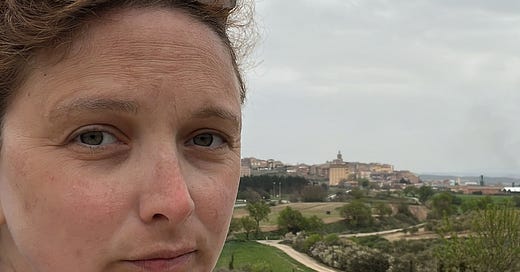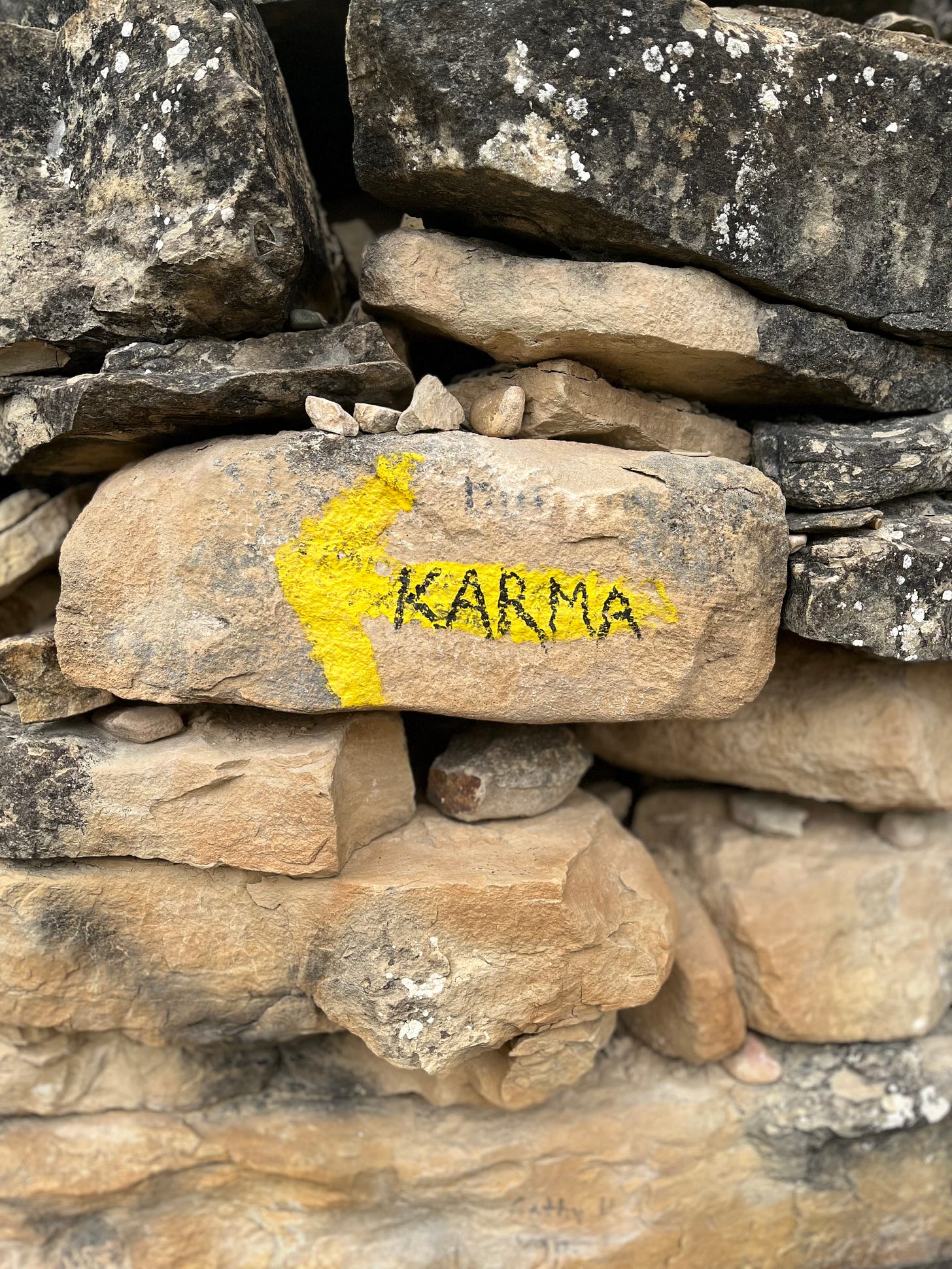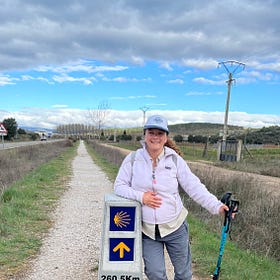Would you walk 500 miles to find yourself in the wilderness?
A Homily for the Second Sunday in Lent
I am a lay preacher in my Episcopal Church in New Milford, CT, in which capacity I have the opportunity to deliver a Homily at a morning prayer service once or twice a year. The Homily responds to that day’s Lectionary, selected readings from the Old Testament, the Psalms, the New Testament, and the Gospel. Today’s readings, which are referenced in bold throughout this essay, can be found here.
People exist on a wide spectrum of faith in the divine, and those who don’t regularly participate in organized religion may resist today’s many mentions of “God.” Please know that I hold space with a loving heart for all the names we use for the divine spirit working within and among us. I am grateful for the example of
who is one of the best at navigating the space between doubt and faith.Today I’d like to share a reflection on my experience walking the Camino during Lent.
For those who may be unfamiliar, as I once was, the Camino de Santiago, or the Way of Saint James, is a network of Catholic pilgrimage routes that crisscross northern Spain. Dating back to the 800s, they were first well-worn by pilgrims seeking indulgences from the Medieval church. Today, they have become both an ecumenical and tourist destination for adventurous travelers seeking to immerse themselves in the divine beauty of the Spanish countryside.
I first learned about the Camino de Santiago in the summer of 2012 when a British friend shared that she and her boyfriend had taken a walking holiday there, where he proposed. Until then, I hadn’t known that northern Spain was filled with hundreds of miles of pilgrimage paths that led from far flung places to the shrine of Saint James at the Cathedral of Santiago de Compostela. A quick search revealed that a complete pilgrimage on the Camino Frances, the most popular route, which starts in southwest France, is 500 miles long and often completed in 33 days to honor the length of Jesus's life.
Thirty Three Days, I thought. Who could possibly make time for that?
I didn’t realize that in that moment, the seed of Camino had been firmly planted inside me, just waiting to take root.
Hearken to my voice, O LORD, when I call. Have mercy on me and answer me.
I decided to walk the Camino for the first time in the summer of 2019. My life was in a knot of complexity. I was moving to Europe to stay in an unhappy marriage. I didn’t have a job or a life direction. I thought maybe five weeks on the Camino could help me shed my doubts and fears. Living in Germany at the time, the Camino was only a train ride away. I felt the seed starting to germinate and find its roots.
I could feel the call to find the path. But I struggled to find the courage to make the journey.
O Tarry and await the LORD’s pleasure, be strong and God shall comfort your heart.
God had other plans. The fall of 2019 turned out to be a season of No. I said no to Camino, no to work, and ultimately, no to staying in my marriage. I got on a plane out of Europe on March 18, 2020 just before mandatory lockdowns closed airports around the world.
Do not be afraid, the Lord said to Abraham, for your reward shall be great.
I had all but given up on the idea that the Camino would ever be within reach. And then, in the summer of 2021, the door opened again.
My mother in law Susan and my late father in law Will invited Andy and me to join them on a 10 day holiday in Galicia in northern Spain. The proposed itinerary began and ended in Santiago de Compostela, the end-point of the Camino.
Was this a sign from God? I wondered. Was now the time?
What if I had not believed that I should see the goodness of the Lord in the land of the living?
I was busy strategizing about how I could manage 33 days of walking and working in advance of our 10-day holiday in the midst of a busy life when I found out I was pregnant with our son Felix. My due date fell just two weeks after our proposed date of return.
Oh boy, I thought. That’s gonna make this complicated.
I anticipated that walking at least 12 miles a day while 30 plus weeks pregnant would be all-consuming, which threw the ‘walk and work’ plan out the window.
Was I ready to spend six of my last ten weeks of pregnancy alone on a Spanish hillside?
But if I didn’t walk now, when would I find the time? Faced with the demands of my new baby, it could be another decade.
Suddenly, walking the Camino felt both essential and existential.
Everyone around me worried about the logistics and constraints of me walking pregnant and alone. But I was in good health, and the midwives at the Danbury Birth Center insisted that so long as I stayed hydrated and monitored my blood pressure, they didn’t see a reason the journey would put me or my baby at risk.
And, I couldn’t shake the feeling of God’s hand on my shoulder comforting my anxieties and urging me on. For whatever reason, now was the time.
My first lesson of Camino emerged before I had even taken my first step. Sometimes it is possible to close our ears, unwilling to hear God’s intent. But sooner or later, it will make itself known.
Show me your way, O LORD, lead me on a level path.
On March 18th, the same day I had left Europe two years earlier, I boarded a plane to France to begin my journey. On March 20th – the spring equinox – I started walking, with plans to arrive in Santiago by May 1.
Forty days comes up again and again in the Bible, and as I began my journey, I started to understand why. Forty days is a long enough time that by the end of it, you may struggle to remember exactly how you felt at the beginning. Forty days of solitude will change you, whether you want it to or not.
Like today, the season of Lent had already begun. I had decided to walk for 40 days for practical reasons, rather than biblical ones. Mid-March is when the Camino first opens for the season after the winter snow melts. Walking an average of 12 miles a day, 40 days was the minimum amount of time I needed to reach Santiago by May 1, when our family holiday began. And yet, its biblical significance was hard to shake.
I knew that being away would be a serious wilderness fast. I also knew it would give me extended periods of contemplation and solitude I would almost certainly struggle to find in the coming years of new motherhood.
I had the feeling I needed space to be broken open to prepare for the journey ahead, but by what, I did not yet know.
Pilgrims usually carry everything they need in a hiking pack, and for my first ten days of walking, I insisted on doing the same, carrying a pack that weighed nearly 25 pounds, even as my body was already 25 pounds pregnant. I took my time getting over the mountains between France and Spain on my first two days, counting my steps as needed to make it through the long uphill climbs. I’d take one step every second for 100 seconds and then pause and breathe for 30 seconds before starting again.
Was this preparation for labor? I wondered.
But after the first few days, my feet started to ache so badly I could scream. Foot pain and blisters are not uncommon on Camino, but my poor circulation induced by pregnancy was only making that worse.
On my tenth day, I walked into Logrono – a fairly big city – and went looking for a midwife, to make sure the extreme pain I was feeling wasn’t causing me or my baby any harm
By the grace of God, I found myself in the care of an incredibly wise and gentle midwife named Balén. When I tried to explain why an American would be walking the Camino in her third trimester, she nodded, knowingly. She had completed the Camino not once but three times, and understood completely the urge to respond when God calls. She performed a sonogram and a fetal stress test and confirmed that all was well with the baby. When I told her about the pain in my feet her brow furrowed slightly, and she asked if I was carrying a backpack. Yes, I confirmed, explaining that I wanted to have the real pilgrim experience. She nodded and thought for a moment before speaking.
My dear, she said, you have a backpack in your belly.
Of course she was right. The weight I was carrying on my back would have little bearing on the transformation happening in my body, heart, and soul. The next day, I ordered a service to carry my backpack for me. Suddenly 25 pounds lighter, the next day’s journey felt easy.
He will transform the body of our humiliation that it may be confirmed to the body of his glory, Paul said.
Sometimes unburdening ourselves of the things we choose to carry can bring us closer to God.
It is said by many that the first stage of the Camino is physical, the second is psychological, and the last, spiritual, which I found to be true.
Putting down the physical pain caused by my pack left me with lots of time and space to interrogate my life’s meaning and begin my journey into the psychological stage.
Another truism I repeated to myself often on Camino is, the only way out is through. After passing the halfway point, there is little sense in turning back. But there’s still 250 miles to go. You’re in the middle of the great flat expanse of the Iberian plateau with nothing to do but mindlessly put one plodding foot in front of the other and think about what you’ve left undone.
The only child of parents who divorced when I was three, my childhood was lonely and short. By the time I was eight, I would fly by myself from Albany to Washington DC to spend one weekend a month with my dad. I’d always been proud of how this experience had made me resilient and wise beyond my years. But in the wide open expanse of Northern Spain, tears of grief for the childhood I never had flowed freely. With no one around to see me cry, I turned to God for comfort.
The line between loneliness and solitude is somewhere between the love we can summon for ourselves and the love shown to us by others. During my childhood, I had often felt alone, and the Camino plunged me back into that same feeling. I worried that I wouldn’t be able to unwind this knot of insecurity and misgiving before my son was born.
Every day, I arrived somewhere new to sleep, needing to find a place to eat. And every day offered the choice to see the people around me as strangers I would likely never meet again or as the bearers of God’s love.
Had I built a life filled with enough love to let me give my son the tenderness I had always wished for but never known?
Letting go of the pain I had been unwittingly holding onto created space for me to feel an abundance of love both inside me and around me.
And isn’t that the ultimate Lenten invitation?
To give up the things that burden us so that we might find both within and without the love that brings us closer to God?
Towards the end of my journey, I approached the Cruz de Fierro, the highest point on the Camino which is marked by a simple iron cross atop a thin wooden pole. As is customary, I’d carried a stone with me since leaving home, and I’d picked one up on my way into Logroño that I’d carried the rest of the way. They’d become a kind of talisman for the choices I had made that had kept me from the Camino for so long, and the childhood grief I had uncovered during the journey
I made my way up the giant pile of stones that represents the castoff burdens of pilgrims amassed over hundreds of years and I knelt down, my belly heavy, to find a place to lay my stones to rest.
I closed my eyes and prayed:
Please God, let me put down these heavy weights I have carried for too long.
Let me fill the space created by their surrender with the deepest kind of love.
Observe, says Paul, those who live according to the example you have in us.
After my 40 days of solitude on the Camino, I could more easily imagine the clarity and conviction Jesus must have felt as he emerged from the wilderness.
In this chapter of Luke, Jesus is too busy to have time to be afraid.
“Can’t you see I’m working over here?” he seems to say.
And yet, we know how this story ends. The rap duo Run the Jewels summarizes it well:
Never forget in the story of Jesus, the hero is killed by the state.
Is America today any different from Jerusalem?
In a time of growing inequality and political uncertainty, who will we choose to be?
Will we cower in fear? Or stand strong in a conviction to live differently? Will we love one another as we love ourselves, knowing that to do so may be to risk persecution?
In this moment, the greatest form of resistance isn’t protest but the most committed and generous unconditional love.
When Jesus says: You will not see me until the time comes when you say, “Blessed is the one who comes in the name of the Lord,” I believe he’s calling us not just to believe in him, but in each other.
May we all find the courage and strength to listen when God calls us, to realize the blessing God sees in each of us.
Amen.
This is the first of two Homilies I delivered this spring. The one, above, was given during Lent. The second, delivered on the second sunday in Easter, can be read here:
Persevering Through Doubt
Today’s post is the second of two Homilies I’ve delivered this year as a lay preacher at St. John’s, the Episcopal Church in New Milford, CT (read the first, here). It responds to today’s Lectionary, selected readings from the Old Testament, the Psalms, the New Testament, and the Gospel. Today’s readings, referenced in the homily, can be found









Love this piece and lovely to read and remember the before. Trust you and Felix and hubby well.